

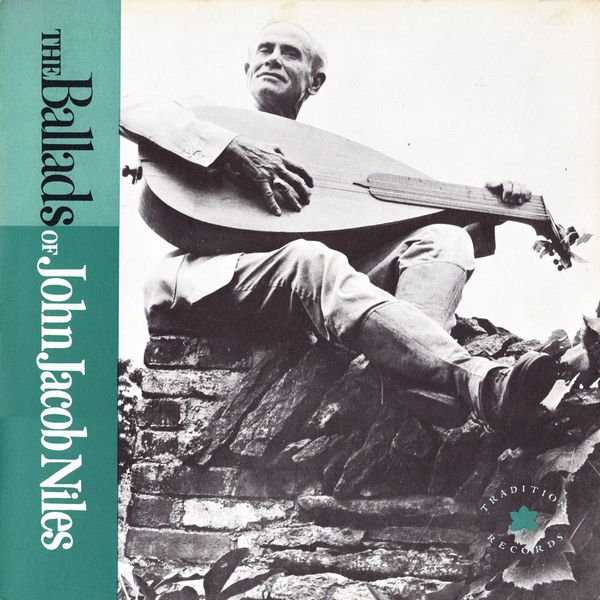 |
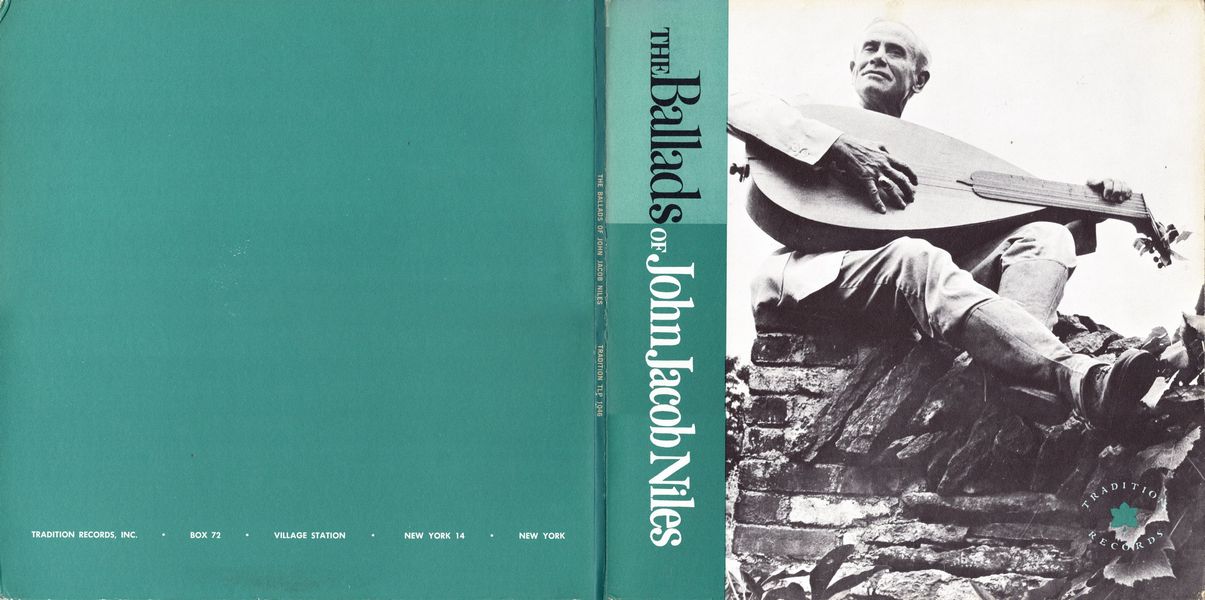
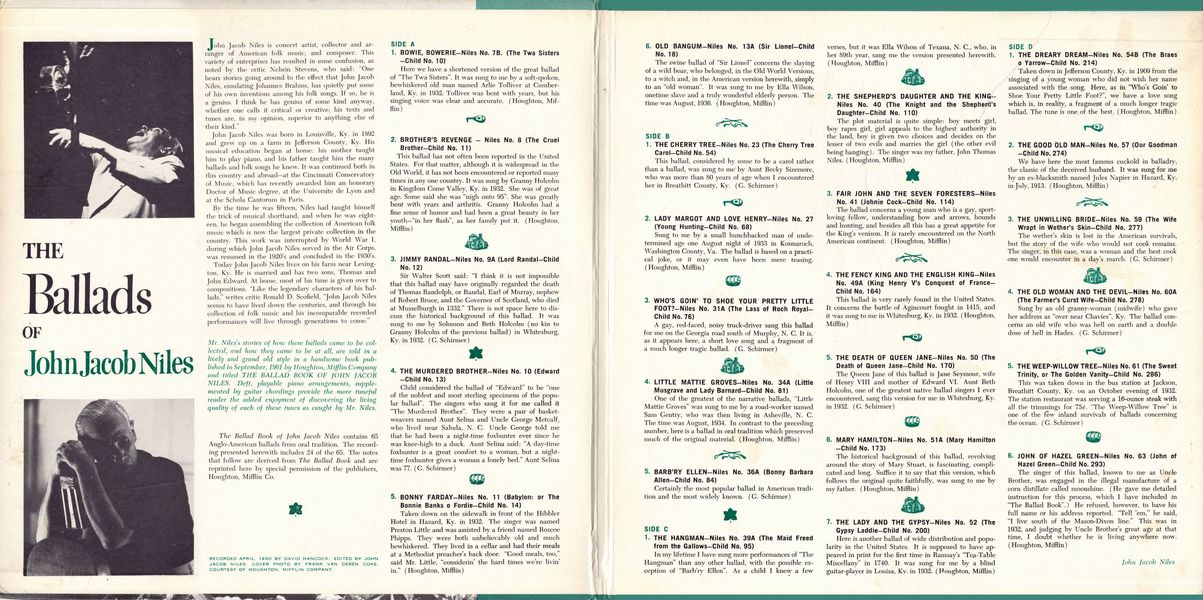 |
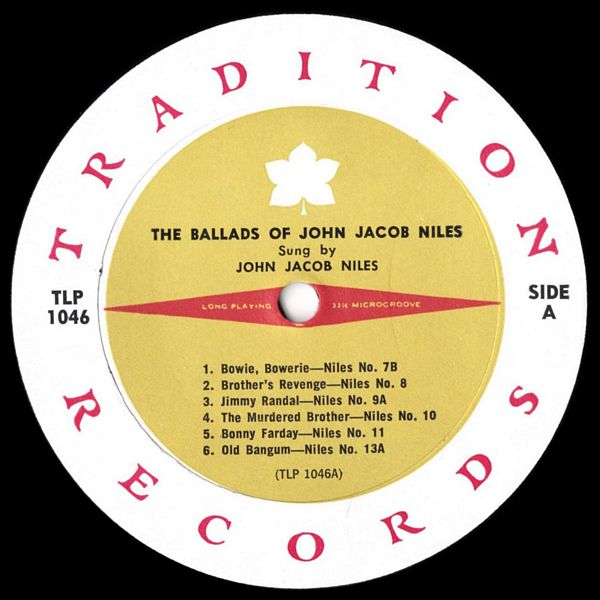
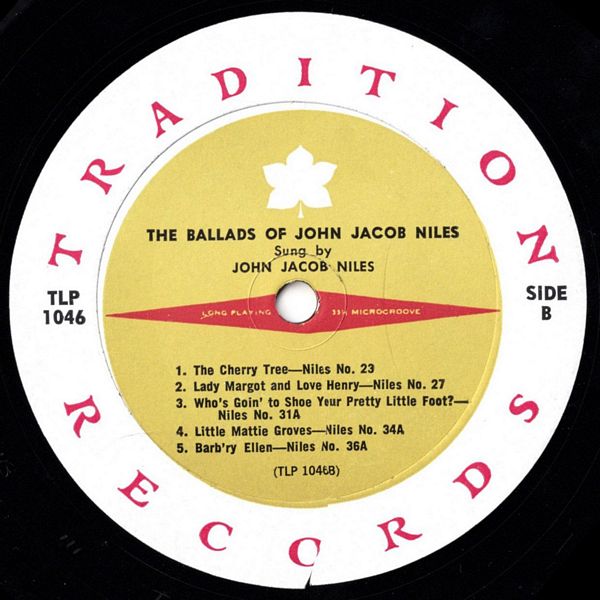
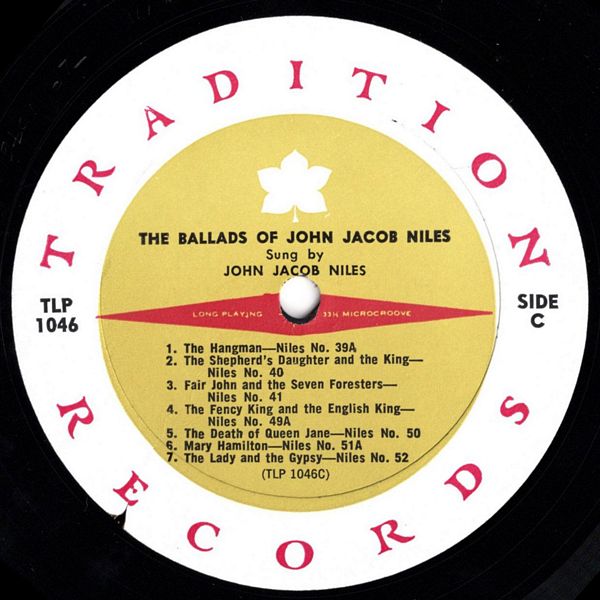
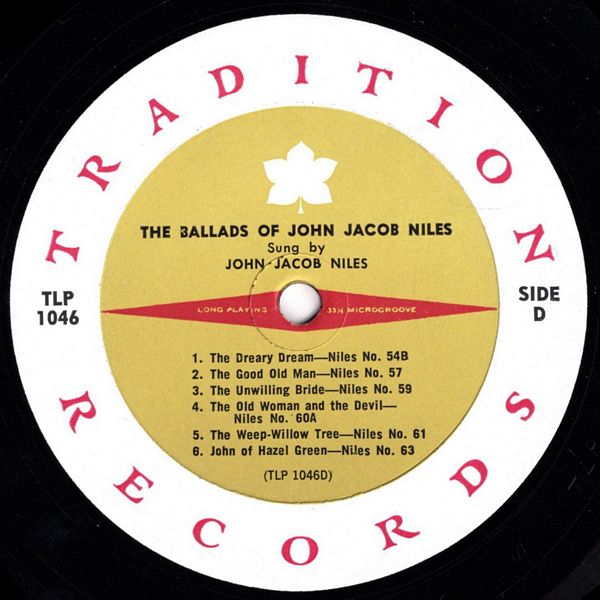
|
Sleeve Notes
John Jacob Niles is concert artist, collector and arranger of American folk music, and composer. This variety of enterprises has resulted in some confusion, as noted by the critic Nelson Stevens, who said: "One hears stories going around to the effect that John Jacob Niles emulating Johannes Brahms, has quietly put some of his own inventions among his folk songs. If so. he is a genius. I think he has genius of some kind anyway. whether one calls it critical or creative: his texts and tunes are, in my opinion, superior to anything else of their kind."
John Jacob Niles was born in Louisville, Ky. in 1892 and grew up on a farm in Jefferson County, Ky. His musical education began at home: his mother taught him to play piano, and his father taught him the many ballads and folk songs he knew. It was continued both in this country and abroad — at the Cincinnati Conservatory of Music, which has recently awarded him an honorary Doctor of Music degree, at the Universite de Lyon and at the Schola Cantorum in Paris.
By the time he was fifteen, Niles had taught himself the trick of musical shorthand, and when he was eighteen, he began assembling the collection of American folk music which is now the largest private collection in the country. This work was interrupted by World War I. during which John Jacob Niles served in the Air Corps, was resumed in the 1920's and concluded in the 1930's.
Today John Jacob Niles lives on his farm near Lexington, Ky. He is married and has two sons, Thomas and John Edward. At home, most of his time is given over to compositions. "Like the legendary characters of his ballads," writes critic Ronald D. Scofield, "John Jacob Niles seems to have lived down the centuries, and through his collection of folk music and his incomparable recorded performances will live through generations to come.
Mr. Niles's stories of how these ballads came to be collected, and how they came to be at all, are told in a lively and grand old style in a handsome book published in September, 1961 by Houghton, Mifflin Company and titled THE BALLAD BOOK OF JOHN JACOB NILES. Deft, playable piano arrangements, supplemented by guitar chordings provide the more tuneful reader the added enjoyment of discovering the living quality of each of these tunes as caught by Mr. Niles.
The Ballad Book of John Jacob Niles contains 65 Anglo-American ballads from oral tradition. The recording presented herewith includes 24 of the 65. The notes that follow are derived from The Ballad Book and are reprinted here by special permission of the publishers. Houghton, Mifflin Co.
BOWIE, BOWERIE — Niles No. 7B. (The Twa Sisters — Child No. 10)
Here we have a shortened version of the great ballad of "The Twa Sisters". It was sung to me by a soft-spoken, bewhiskered old man named Arlie Tolliver at Cumberland, Ky. in 1932. Tolliver was bent with years, but his singing voice was clear and accurate. (Houghton, Mifflin)
BROTHER'S REVENGE — Niles No. 8 (The Cruel Brother — Child No. 11)
This ballad has not often been reported in the United States. For that matter, although it is widespread in the Old World, it has not been encountered or reported many times in any one country. It was sung by Granny Holcolm in Kingdom Come Valley, Ky. in 1932. She was of great age. Some said she was "nigh onto 95". She was greatly bent with years and arthritis. Granny Holcolm had a fine sense of humor and had been a great beauty in her youth — "in her flash", as her family put it. (Houghton, Mifflin)
JIMMY RANDAL — Niles No. 9A (Lord Randal — Child No. 12)
Sir Walter Scott said: "I think it is not impossible that this ballad may have originally regarded the death of Thomas Randolph, or Randal, Earl of Murray, nephew of Robert Bruce, and the Governor of Scotland, who died at Musselburgh in 1332." There is not space here to discuss the historical background of this ballad. It was sung to me by Solomon and Beth Holcolm (no kin to Granny Holcolm of the previous ballad) in Whitesburg, Ky. in 1932. (G. Schirmer)
THE MURDERED BROTHER — Niles No. 10 (Edward — Child No. 13)
Child considered the ballad of "Edward" to be "one of the noblest and most sterling specimens of the popular ballad". The singers who sang it for me called it "The Murdered Brother". They were a pair of basket-weavers named Aunt Selina and Uncle George Metcalf, who lived near Saluda, N. C. Uncle George told me that he had been a night-time foxhunter ever since he was knee-high to a duck. Aunt Selina said: "A day-time foxhunter is a great comfort to a woman, but a night-time foxhunter gives a woman a lonely bed." Aunt Selina was 77. (G. Schirmer)
BONNY FARDAY — Niles No. 11 (Babylon: or The Bonnie Banks o Fordie — Child No. 14)
Taken down on the sidewalk in front of the Hibbler Hotel in Hazard, Ky. in 1932. The singer was named Preston Little and was assisted by a friend named Roscoe Phipps. They were both unbelievably old and much bewhiskered. They lived in a cellar and had their meals at a Methodist preacher's back door. "Good meals, too," said Mr. Little, "considerin' the hard times we're livin' in." (Houghton, Mifflin)
OLD BANGUM — Niles No. 13A (Sir Lionel — Child No. 18)
The swine ballad of "Sir Lionel" concerns the slaying of a wild boar, who belonged, in the Old World Versions, to a witch and, in the American version herewith, simply to an "old woman". It was sung to me by Ella Wilson, onetime slave and a truly wonderful elderly person. The time was August, 1936. (Houghton, Mifflin)
THE CHERRY TREE — Niles No. 23 (The Cherry Tree Carol — Child No. 54)
This ballad, considered by some to be a carol rather than a ballad, was sung to me by Aunt Becky Sizemore, who was more than 80 years of age when I encountered her in Breathitt County, Ky. (G. Schirmer)
LADY MARGOT AND LOVE HENRY — Niles No. 27 (Young Hunting — Child No. 68)
Sung to me by a small hunchbacked man of undetermined age on an August night of 1933 in Konnarocli, Washington County, Va. The ballad is based on a practical joke, or it may even have been mere teasing. (Houghton, Mifflin)
WHO'S GOIN' TO SHOE YOUR PRETTY LITTLE FOOT? — Niles No. 31A (The Lass of Roch Royal — Child No. 76)
A gay, red-faced, noisy truck-driver sang this ballad lor me on the Georgia road south of Murphy, N. C. It is, as it appears here, a short love song and a fragment of a much longer tragic ballad. (G. Schirmer)
LITTLE MATTIE GROVES — Niles No. 34A (Little Musgrave and Lady Barnard — Child No. 81)
One of the greatest of the narrative ballads, "Little Mattie Groves" was sung to me by a road-worker named Sam Gentry, who was then living in Asheville, N. C. The time was August, 1934. In contrast to the preceding number, here is a ballad in oral tradition which preserved much of the original material. (Houghton, Mifflin)
BARB'RY ELLEN — Niles No. 36A (Bonny Barbara Allen — Child No. 84)
Certainly the most popular ballad in American tradition and the most widely known. (G. Schirmer)
THE HANGMAN — Niles No. 39A (The Maid Freed from the Gallows — Child No. 95)
In my lifetime I have sung more performances of "The Hangman" than any other ballad, with the possible exception of "Barb'ry Ellen". As a child I knew a few verses, but it was Ella Wilson of Texana, N. C., who, in her 89th year, sang me the version presented herewith. (Houghton, Mifflin)
THE SHEPHERD'S DAUGHTER AND THE KING — Niles No. 40 (The Knight and the Shepherd's Daughter — Child No. 110)
The plot material is quite simple: boy meets girl, boy rapes girl, girl appeals to the highest authority in the land, boy is given two choices and decides on the lesser of two evils and marries the girl (the other evil being hanging). The singer was my father, John Thomas Niles. (Houghton, Mifflin)
FAIR JOHN AND THE SEVEN FORESTERS — Niles No. 41 (Johnie Cock — Child No. 114)
The ballad concerns a young man who is a guy, sport-loving fellow, understanding bow and arrows, hounds and hunting, and besides all this has a great appetite lor the King's venison. It is rarely encountered on the North American continent. (Houghton, Mifflin)
THE FENCY KING AND THE ENGLISH KING — Niles No. 49A (King Henry V's Conquest of France — Child No. 164)
This ballad is very rarely found in the United States. It concerns the battle of Agincourt fought in 1415, and it was sung to me in Whitesburg, Ky. in 1932. (Houghton, Mifflin)
THE DEATH OF QUEEN JANE — Niles No. 50 (The Death of Queen Jane — Child No. 170)
The Queen Jane of this ballad is Jane Seymour, wife of Henry VIII and mother of Edward VI. Aunt Beth Holcolm, one of the greatest native ballad singers I ever encountered, sang this version for me in Whitesburg, Ky. in 1932. (G. Schirmer)
MARY HAMILTON — Niles No. 51A (Mary Hamilton — Child No. 173)
The historical background of this ballad, revolving around the story of Mary Stuart, is fascinating, complicated and long. Suffice it to say that this version, which follows the original quite faithfully, was sung to me by my father. (Houghton, Mifflin)
THE LADY AND THE GYPSY — Niles No. 52 (The Gypsy Laddie — Child No. 200)
Here is another ballad of wide distribution and popularity in the United States. It is supposed to have appeared in print for the first time in Ramsay's "Tea-Table Miscellany" in 1740. It was sung for me by a blind guitar-player in Louisa, Ky. in 1932. (Houghton, Mifflin)
THE DREARY DREAM — Niles No. 54B (The Braes o Yarrow — Child No. 214)
Taken down in Jefferson County, Ky. in 1909 from the singing of a young woman who did not wish her name associated with the song. Here, as in "Who's Goin' to Shoe Your Pretty Little Foot?", we have a love song which is, in reality, a fragment of a much longer tragic ballad. The tune is one of the best. (Houghton, Mifflin)
THE GOOD OLD MAN — Niles No. 57 (Our Goodman — Child No. 274)
We have here the most famous cuckold in balladry, the classic of the deceived husband. It was sung for me by an ex-blacksmith named Jules Napier in Hazard, Ky. in July, 1913. (Houghton, Mifflin)
THE UNWILLING BRIDE — Niles No. 59 (The Wife Wrapt in Wether's Skin — Child No. 277)
The wether's skin is lost in the American survivals, but the story of the wife who would not cook remains. The singer, in this case, was a woman and the best cook one would encounter in a day's march. (G. Schirmer)
THE OLD WOMAN AND THE DEVIL — Niles No. 60A (The Farmer's Curst Wife — Child No. 278)
Sung by an old granny-woman (midwife) who gave her address as "over near Chavies", Ky. The ballad concerns an old wife who was hell on earth and a double dose of hell in Hades. (G. Schirmer)
THE WEEP-WILLOW TREE — Niles No. 61 (The Sweet Trinity, or The Golden Vanity — Child No. 286)
This was taken down in the bus station at Jackson, Breathitt County, Ky. on an October evening of 1932. The station restaurant was serving a 16-ounce steak with all the trimmings for 75^. "The Weep-Willow Tree" is one of the few inland survivals of ballads concerning the ocean. (G. Schirmer)
JOHN OF HAZEL GREEN — Niles No. 63 (John of Hazel Green — Child No. 293)
The singer of this ballad, known to me as Uncle Brother, was engaged in the illegal manufacture of a corn distillate called moonshine. (He gave me detailed instruction for this process, which I have included in "The Ballad Book".) He refused, however, to have his full name or his address reported. "Tell 'em," he said, "I live south of the Mason-Dixon line." This was in 1932, and judging by Uncle Brother's great age at that time, I doubt whether he is living anywhere now. (Houghton, Mifflin)
John Jacob Niles